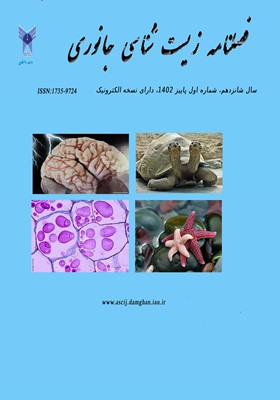بررسی تاثیر ترانسچالکون بر روی فیبریلاسیون پروتئین انسولین
محورهای موضوعی : فصلنامه زیست شناسی جانوری
ماریا امیدی شاهسوندی
1
![]() ,
پریچهره یغمایی
2
,
شهین احمدیان
3
,
پریچهره یغمایی
2
,
شهین احمدیان
3
![]() ,
آزاده ابراهیم حبیبی
4
,
آزاده ابراهیم حبیبی
4
![]()
1 - گروه بیولوژی، واحد علوم و تحقیقات، دانشگاه آزاد اسلامی، تهران، ایران
2 - گروه بیولوژی، واحد علوم و تحقیقات، دانشگاه آزاد اسلامی، تهران، ایران
3 - مرکز تحقیقات بیوشیمی و بیوفیزیک تهران، دانشگاه تهران، تهران، ایران
4 - مرکز تحقیقات غدد درن ریز و متابولیسم، دانشگاه علوم پزشکی تهران، تهران، ایران
کلید واژه: انسولین, کنگورد, داکینگ, تجمعات آمیلوئیدی, ترانسچالکون, ترکیبات آروماتیک, تیوفلاوینS,
چکیده مقاله :
فیبریل های آمیلوئیدی تجمعات رشته مانندی هستند که از باز شدن ساختار طبیعی و بدتاخوردگی انواع مختلف پپتیدها و پروتئین ها بوجود می آیند. این تجمعات آمیلوئیدی با برخی از بیماری ها نظیر بیماری های تحلیل برنده عصبی و سیستماتیک از قبیل آلزایمر، پارکینسون و دیابت نوع دو در ارتباط می باشند. هدف از این مطالعه بررسی اثرات مهاری ترانسچالکون در مهار فرایند فیبریلاسیون انسولین (پروتئین مدل) می باشد. در مرحله اول با استناد به مطالعات انجام شده، شرایط مناسب برای تشکیل فیبریل های آمیلوئیدی برای پروتئین مدل مد نظر ما فراهم شد. سپس پپتید انسولین در حضور و عدم حضور ترانسچالکون به مدت 24 ساعت در شرایط تشکیل تجمعات آمیلوئیدی انکوبه شد و فیبریل های تشکیل شده با تکنیک های مختلف از جمله مطالعه تغییرات جذب نوری کنگورد با تکنیک اسپکتروسکوپی، تصاویر حاصل از میکروسکوپ الکترونی گذاره (TEM) و تصویربرداری و آنالیز تجمعات آمیلوئیدی با میکروسکوپ فلورسان بررسی شدند در نهایت، با استفاده از روش داکینگ مولکولی توسط نرم افزار AutoDock برهمکنش های احتمالی ترکیب ترانسچالکون با پپتید انسولین تحلیل شد. نتایج حاصل از پژوهش، کاهش قابل ملاحظه تجمعات آمیلوئیدی را در نمونه تغییر داده شده نسبت به نمونه شاهد نشان داد.
Amyloid fibrils are string-like aggregates that form due to the disruption of natural structure and misfolding of various types of peptides and proteins. These amyloid aggregates are associated with some neurodegenerative and systemic diseases such as Alzheimer's, Parkinson's, and type 2 diabetes. The aim of this study was to investigate the inhibitory effects of Trans-chalcone on insulin fibrillation (as a model protein). In this study, insulin was incubated for 24 hours in the presence and absence of Trans-chalcone under amyloid formation conditions. The formed fibrils were analyzed using various techniques including Congo red absorption spectral changes by spectroscopy, electron microscopy images by TEM, and fluorescent staining of amyloid aggregates by fluorescent microscopy. Then, possible interactions between Trans-chalcone and insulin were analyzed using molecular docking method by AutoDock software. The results showed a significant reduction in amyloid fibril formation in the additive-containing sample compared to the control sample. This study provides evidence that Trans-chalcone has an inhibitory effect on insulin fibrillation and could be a potential therapeutic agent for amyloid-related diseases.
_||_


